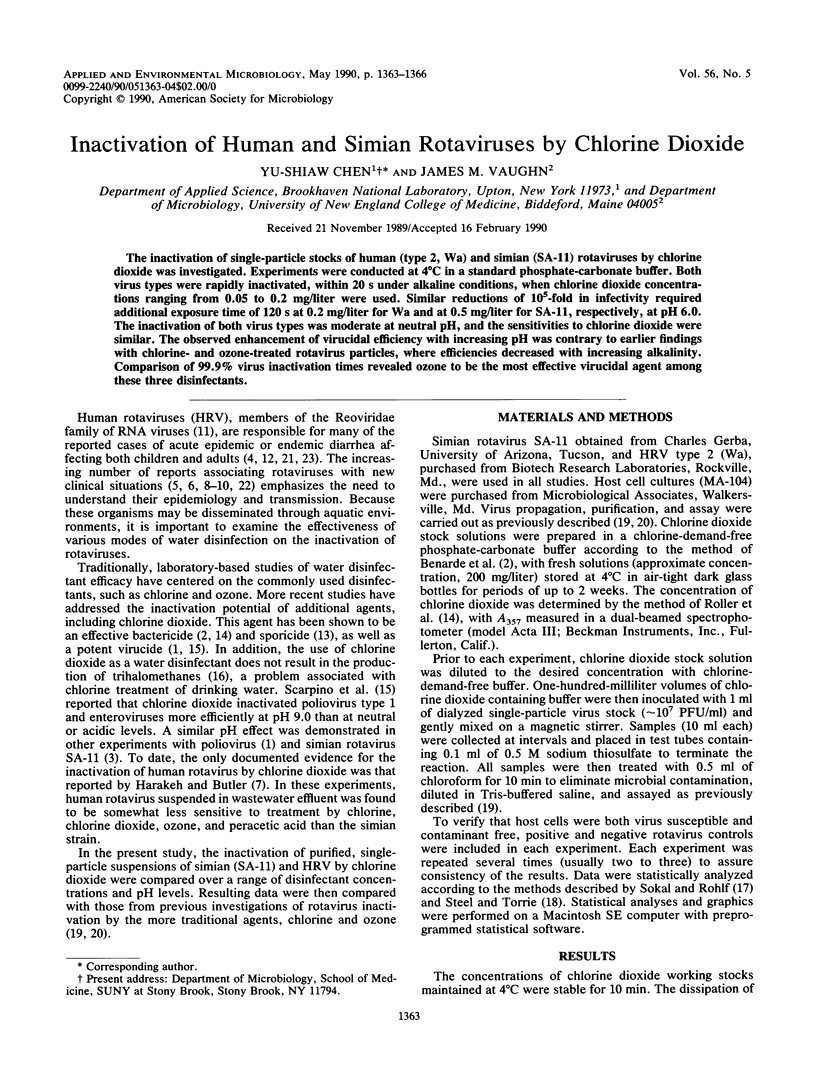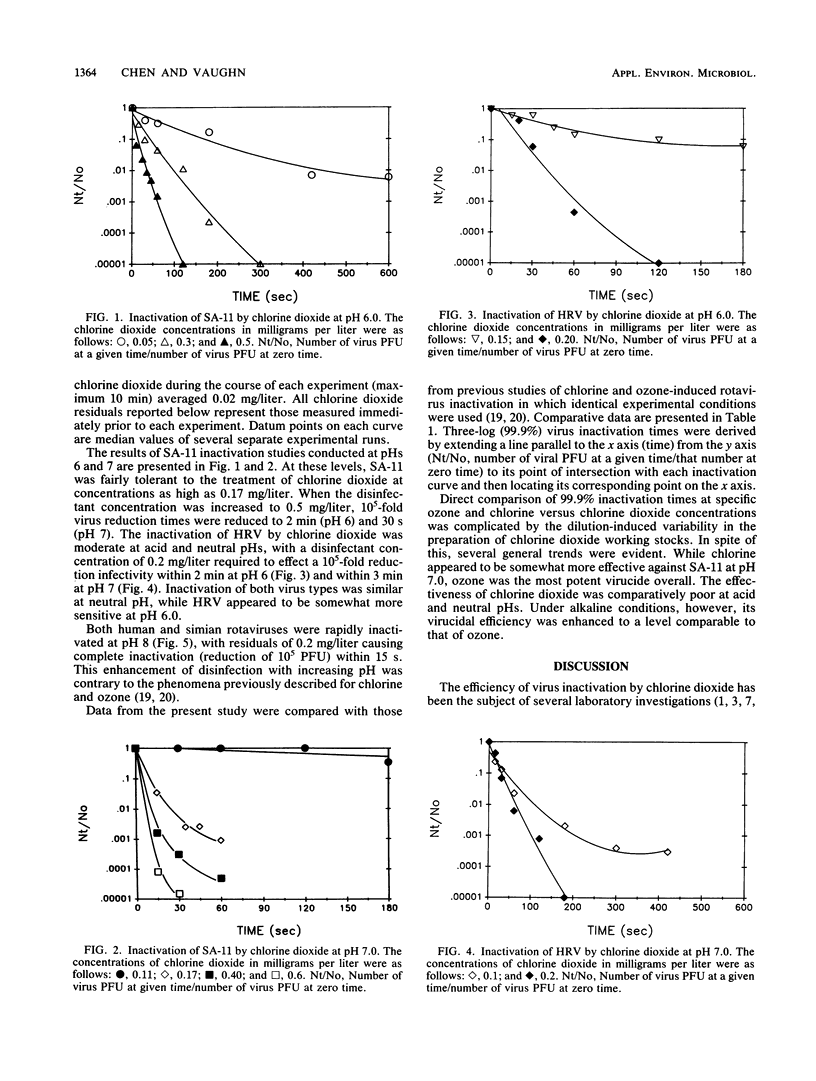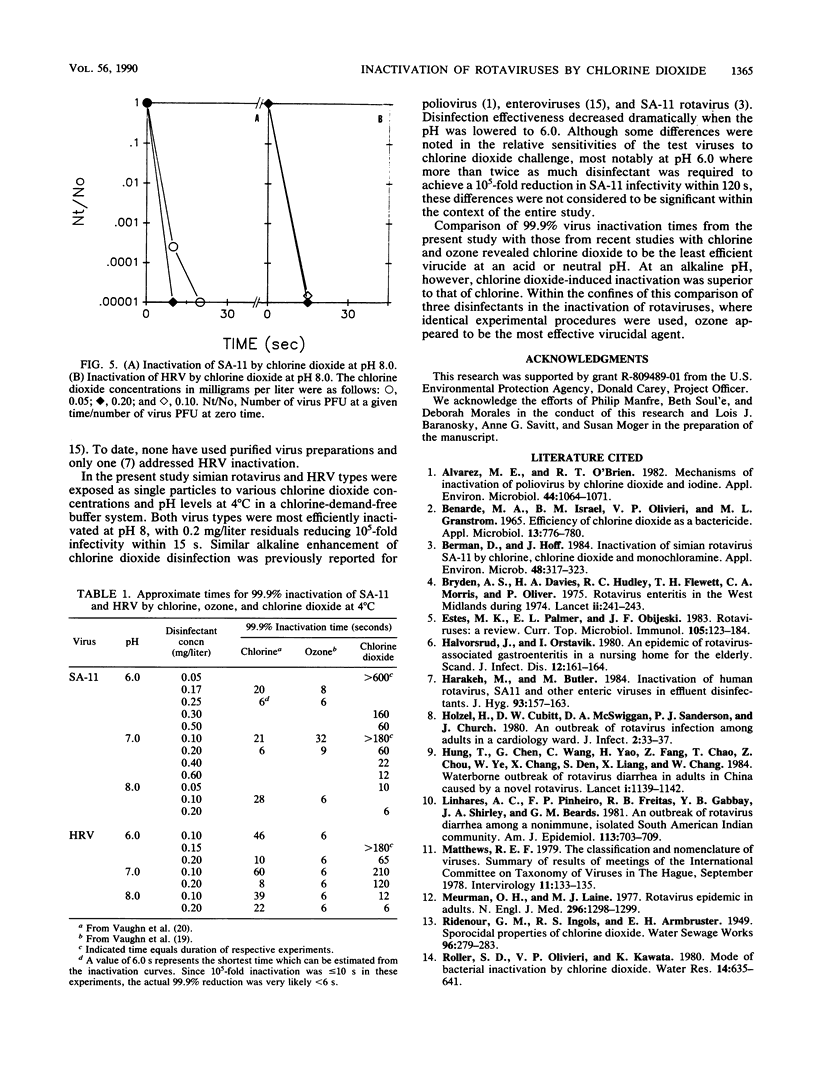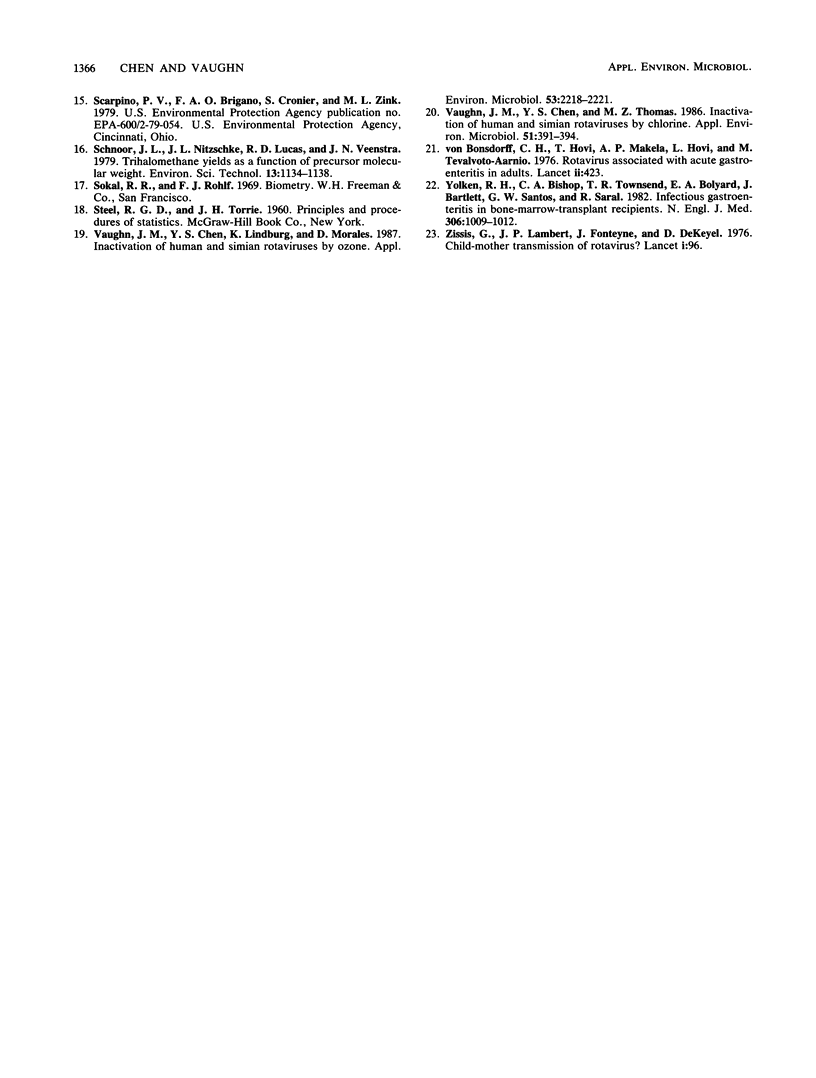Abstract
The inactivation of single-particle stocks of human (type 2, Wa) and simian (SA-11) rotaviruses by chlorine dioxide was investigated. Experiments were conducted at 4 degrees C in a standard phosphate-carbonate buffer. Both virus types were rapidly inactivated, within 20 s under alkaline conditions, when chlorine dioxide concentrations ranging from 0.05 to 0.2 mg/liter were used. Similar reductions of 10(5)-fold in infectivity required additional exposure time of 120 s at 0.2 mg/liter for Wa and at 0.5 mg/liter for SA-11, respectively, at pH 6.0. The inactivation of both virus types was moderate at neutral pH, and the sensitivities to chlorine dioxide were similar. The observed enhancement of virucidal efficiency with increasing pH was contrary to earlier findings with chlorine- and ozone-treated rotavirus particles, where efficiencies decreased with increasing alkalinity. Comparison of 99.9% virus inactivation times revealed ozone to be the most effective virucidal agent among these three disinfectants.
Full text
PDF



Selected References
These references are in PubMed. This may not be the complete list of references from this article.
- Alvarez M. E., O'Brien R. T. Mechanisms of inactivation of poliovirus by chlorine dioxide and iodine. Appl Environ Microbiol. 1982 Nov;44(5):1064–1071. doi: 10.1128/aem.44.5.1064-1071.1982. [DOI] [PMC free article] [PubMed] [Google Scholar]
- Benarde M. A., Israel B. M., Olivieri V. P., Granstrom M. L. Efficiency of chlorine dioxide as a bactericide. Appl Microbiol. 1965 Sep;13(5):776–780. doi: 10.1128/am.13.5.776-780.1965. [DOI] [PMC free article] [PubMed] [Google Scholar]
- Berman D., Hoff J. C. Inactivation of simian rotavirus SA11 by chlorine, chlorine dioxide, and monochloramine. Appl Environ Microbiol. 1984 Aug;48(2):317–323. doi: 10.1128/aem.48.2.317-323.1984. [DOI] [PMC free article] [PubMed] [Google Scholar]
- Bryden A. S., Davies H. A., Hadley R. E., Flewett T. H. Rotavirus enteritis in the West Midlands during 1974. Lancet. 1975 Aug 9;2(7928):241–243. doi: 10.1016/S0140-6736(75)90959-9. [DOI] [PMC free article] [PubMed] [Google Scholar]
- Estes M. K., Palmer E. L., Obijeski J. F. Rotaviruses: a review. Curr Top Microbiol Immunol. 1983;105:123–184. doi: 10.1007/978-3-642-69159-1_3. [DOI] [PubMed] [Google Scholar]
- Halvorsrud J., Orstavik I. An epidemic of rotavirus-associated gastroenteritis in a nursing home for the elderly. Scand J Infect Dis. 1980;12(3):161–164. doi: 10.3109/inf.1980.12.issue-3.01. [DOI] [PubMed] [Google Scholar]
- Harakeh M., Butler M. Inactivation of human rotavirus, SA11 and other enteric viruses in effluent by disinfectants. J Hyg (Lond) 1984 Aug;93(1):157–163. doi: 10.1017/s0022172400061040. [DOI] [PMC free article] [PubMed] [Google Scholar]
- Holzel H., Cubitt D. W., McSwiggan D. A., Sanderson P. J., Church J. An outbreak of rotavirus infection among adults in a cardiology ward. J Infect. 1980 Mar;2(1):33–37. doi: 10.1016/s0163-4453(80)91750-8. [DOI] [PubMed] [Google Scholar]
- Hung T., Chen G. M., Wang C. G., Yao H. L., Fang Z. Y., Chao T. X., Chou Z. Y., Ye W., Chang X. J., Den S. S. Waterborne outbreak of rotavirus diarrhoea in adults in China caused by a novel rotavirus. Lancet. 1984 May 26;1(8387):1139–1142. [PubMed] [Google Scholar]
- Linhares A. C., Pinheiro F. P., Freitas R. B., Gabbay Y. B., Shirley J. A., Beards G. M. An outbreak of rotavirus diarrhea among a nonimmune, isolated South American Indian community. Am J Epidemiol. 1981 Jun;113(6):703–710. doi: 10.1093/oxfordjournals.aje.a113151. [DOI] [PubMed] [Google Scholar]
- Matthews R. E. The classification and nomenclature of viruses. Summary of results of meetings of the International Committee on Taxonomy of Viruses in The Hague, September 1978. Intervirology. 1979;11(3):133–135. doi: 10.1159/000149025. [DOI] [PubMed] [Google Scholar]
- Meurman O. H., Laine M. J. Rotavirus epidemic in adults. N Engl J Med. 1977 Jun 2;296(22):1298–1299. doi: 10.1056/NEJM197706022962220. [DOI] [PubMed] [Google Scholar]
- Vaughn J. M., Chen Y. S., Lindburg K., Morales D. Inactivation of human and simian rotaviruses by ozone. Appl Environ Microbiol. 1987 Sep;53(9):2218–2221. doi: 10.1128/aem.53.9.2218-2221.1987. [DOI] [PMC free article] [PubMed] [Google Scholar]
- Vaughn J. M., Chen Y. S., Thomas M. Z. Inactivation of human and simian rotaviruses by chlorine. Appl Environ Microbiol. 1986 Feb;51(2):391–394. doi: 10.1128/aem.51.2.391-394.1986. [DOI] [PMC free article] [PubMed] [Google Scholar]
- Yolken R. H., Bishop C. A., Townsend T. R., Bolyard E. A., Bartlett J., Santos G. W., Saral R. Infectious gastroenteritis in bone-marrow-transplant recipients. N Engl J Med. 1982 Apr 29;306(17):1010–1012. doi: 10.1056/NEJM198204293061701. [DOI] [PubMed] [Google Scholar]
- Zissis G., Lambert J. P., Fonteyne J., De Kegel D. Letter: Child-mother transmission of rotavirus. Lancet. 1976 Jan 10;1(7950):96–96. doi: 10.1016/s0140-6736(76)90196-3. [DOI] [PubMed] [Google Scholar]
- von Bonsdorff C. H., Hovi T., Mákelá P., Hovi T., Tevalvoto-Aarnio M. Rotavirus associated with acute gastroenteritis in adults. Lancet. 1976 Aug 21;2(7982):423–423. doi: 10.1016/s0140-6736(76)92445-4. [DOI] [PubMed] [Google Scholar]


